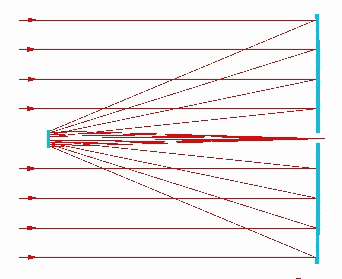


MIRRORS AND TELESCOPES
What are the differences between an optical telescope and an X-ray telescope?
Light rays from a point source at infinity form a parallel bundle (since parallel lines "meet" at infinity). When such a parallel bundle of rays strikes a spherical mirror, the laws of reflection are such that they all pass through nearly the same point, which is the image of the point source. However, they do not all exactly pass through the image. This error in the imaging is called spherical aberration.
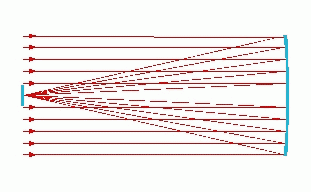
(a) |
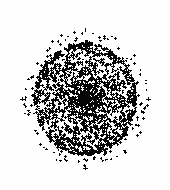
(b) |
At (a), parallel rays are shown incident on a spherical mirror and being focussed to an image on a small screen at the left. The right-hand picture (b) shows on a highly-magnified scale the way in which the image is build up of many rays or photons reflected from the mirror - each dot represents the path of one photon. They do not all go through the same point because of spherical aberration.
![]()
So, in astronomical telescopes (and car headlights) the spherical mirror is often replaced by a parabola, in which all the rays from a point source on the axis of the parabola pass exactly through the image. However, this brings in a different problem -- if the source is not on the axis, the rays no longer pass exactly through the image. This error in the imaging is called coma, and it is greater the further the source is from the axis of the parabola.
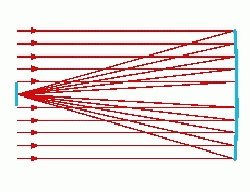
(a) |

(b) |
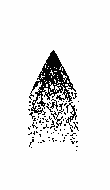
(c) |
Once again, the picture on the left (a) shows rays incident upon a mirror - this time a paraboloid - being focussed on the screen. The picture (b) immediately to the right shows the image, which is now reduced to a dot because spherical aberration has been eliminated. (c) shows what happens when the incident rays are at an angle to the axis of the mirror, i.e., for a source which is not on the axis. This is the effect of coma. The head of the "arrow" points towards the mirror axis. All three images (including that for the spherical mirror) are drawn to the same scale.
![]()
The aberrations can be reduced by using a corrector. In the Cassegrain telescope, which is a common design for optical astronomy, a second mirror is used and various combinations of shapes for the primary and secondary mirrors allow the aberrations to be adjusted. The classical Cassegrain uses a parabola and a hyperbola, but the Ritchey-Chretien has two hyperbolae which allows coma to be eliminated.
|
|
|
![]()
How does an X-ray telescope work?
The Wolter telescope used in XMM is closely related to the Cassegrain telescope used in ground-based optical observatories. However, because X-rays are reflected only at near-grazing angles on the mirror surface, the part of the parabola in front of, rather than behind, the focus is used. This makes the parabola somewhat like a tapering tube. The correcting mirror has the cross-section of a hyperbola as in the classical Cassegrain telescope.
![]()
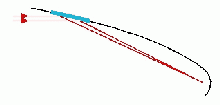
(a) |
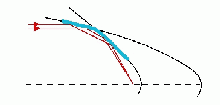
(b) |
(a) shows rays from a paraboloid being focussed at grazing incidence, whilst (b) shows the second reflection at the hyperboloidal surface in a Wolter telescope.
Because the parabolic mirror when viewed from the front has only a rather small useful area, it is necessary to use a large number of them, one inside the other. This is called nesting the mirrors. 58 mirror shells are used in each XMM mirror module.
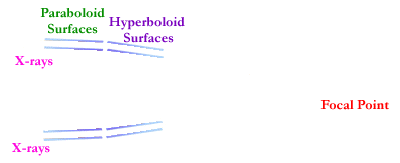
![]()
The parabola, hyperbola and ellipse are all examples of geometric curves called conic sections, because they can be formed by taking sections through a cone at different angles to its axis. The circle (on which the sphere is based) is obviously a special case where the section is perpendicular to the axis of the cone. This shows that all these telescope designs are really very closely related, being combinations of conic sections.
Why are X-rays reflected from a surface?
The reflection of X-rays from a solid surface depends on the presence of electrons in the atoms of the solid, which give it a refractive index which is less than one at X-ray wavelengths (solids have refractive indices greater than one at optical wavelengths). This means that X-rays striking air-metal or vacuum-metal interfaces are going from optically more-dense to optically less-dense media. The same situation exists for ordinary light passing from glass, for example, into air, and in these circumstances total internal reflection of the light can occur. Provided the angle of incidence of the light is greater than a certain critical value, it is reflected at the boundary instead of being refracted into the air as usual. This also happens for X-rays. Provided the incidence angle is great enough (or the grazing angle is small enough) the X-rays are reflected from the surface which thus acts as a mirror. The value of the critical angle depends on the number of electrons per unit volume in the mirror material. This number is particularly large for gold, so this is used for the XMM mirror surfaces.
